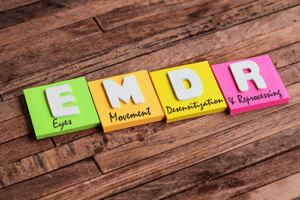HLC’s Eye Movement Desensitization and Reprocessing (EMDR) Therapy Program
Reducing the distress of traumatic memories through evidence-based care.
The body can sometimes remember what the mind wants to forget. However, EMDR can offer healing and hope.
Eye movement desensitization and reprocessing, or EMDR therapy, is offered at Honey Lake Clinic in correlation with other forms of treatment and education. This therapy offers patients an effective method for accessing memories of an event that causes distress, addressing negative thoughts and physiological responses associated with it, and reformulating them.
What Is Eye Movement Desensitization and Reprocessing Therapy?
Eye movement desensitization and reprocessing therapy is an integrative psychotherapy approach proven effective for the treatment of trauma. EMDR uses your own rapid rhythmic eye movements to reduce the distress of emotionally charged memories of past traumatic events. EMDR creates new neuropathways that can make working through these painful experiences an easier task.
 How Does EMDR Work?
How Does EMDR Work?
By recalling distressing events and diverting attention from their emotional consequences, EMDR borrows principles used in prolonged exposure therapy, the standard behavioral psychotherapeutic treatment of PTSD.
How does this work? When a person is very upset, their brain cannot process information as it ordinarily does. You can become stuck remembering and reliving a trauma, feeling just as bad as if you’re going through it the first time. The sights, sounds, smells, and feelings all rush back. Such distressing memories can have a lasting negative effect across all areas of your life.
Typically, EMDR therapy is conducted by a therapist who moves his or her fingers back and forth in front of you. As you follow the movement with your eyes, the therapist guides you in recalling a disturbing event, including all the emotions and body sensations that go along with it. Gradually, the therapist will guide you in shifting your thoughts to more pleasant ones. Some therapists may use alternatives to finger movements, such as hand or toe tapping or musical tones.
Is EMDR Right for You?
Research has established that EMDR is effective in treating post-traumatic stress disorder (PTSD). Studies also report EMDR’s success in treating other conditions, including:
- Panic attacks
- Complicated grief
- Dissociative disorders
- Disturbing memories
- Phobias
- Pain disorders
- Performance anxiety
- Stress reduction
- Addictions
- Sexual and/or physical abuse
- Body dysmorphic disorders
- Personality disorders
“I’ve suffered PTSD having served in Operations Desert Shield and Desert Storm. I’ve wrestled with associated anger, depression, and panic attacks. EMDR therapy has been a breakthrough for me. I’ve been able to get my symptoms under control. Life is manageable again.”
– Garret C., Portland, ME
What to Expect from EMDR Therapy at Honey Lake Clinic
At Honey Lake Clinic, we utilize a three-phase process encompassing the past, present, and future.
- Past – You’ll be aided in discovering past events which laid the groundwork for the distress they are experiencing and its maladaptive links.
- Present – You’ll examine your current circumstances and responses relative to the distress, identifying, targeting, and desensitizing them.
- Future – You’ll develop new image templates of how you want to view this going forward, discovering and employing new adaptive functioning skills.
An EMDR Therapy Program as Unique as Honey Lake Clinic
Our EMDR therapy program at Honey Lake Clinic differs from other treatment providers in that we recognize the importance of incorporating spirituality into every aspect of the treatment process.
EMDR can be applied anywhere, but when it is done in concert with God’s grace and in dependence upon the Holy Spirit’s presence and guidance, we believe the difference is profound.
Honey Lake Clinic patients can expect the reading of scripture, memorization, and prayer to be an integral part of their EMDR experience. “I’d heard those Bible verses before, but this time—in direct relation to what I was feeling and thinking—it was like the light came on, the dots connected. I’ve finally found some peace of mind.” – Leslie V., Pembroke Pines, FL
Learn More About EMDR Therapy at Honey Lake Clinic
EMDR therapy is another example of the unique treatment options available at Honey Lake Clinic, which enable us to help patients address their health across all three spheres—spirit, mind, and body—offering each patient his or her greatest potential for wholeness and transformative growth. A faith-informed model, experienced staff, licensed professional caregivers, and individualized treatment—all in a beautiful and tranquil 1300-acre lakeside setting. Our EMDR therapy program in Greenville, Florida, can help you heal.

 How Does EMDR Work?
How Does EMDR Work?
